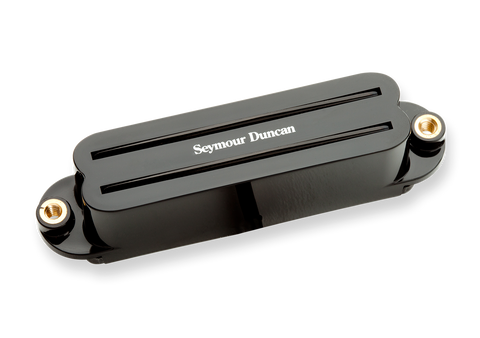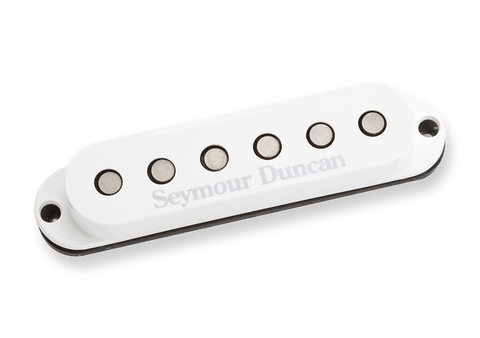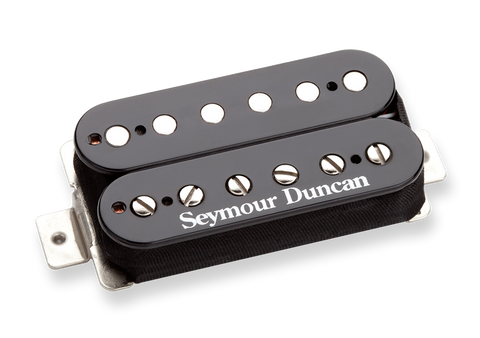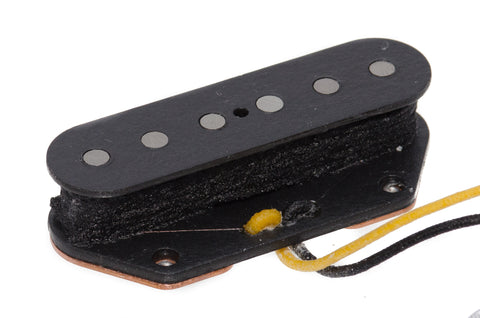From the manufacturer:
"application
P-90 sound without traditional hum. Versatile and applicable for all musical styles.
description
Comes with four-conductor hookup cable which allows for series / parallel / split wiring and tonal options. In series wiring, the tone is loud, brash and great for heavy rock. In parallel wiring, the sound is brighter and thinner and better suited to jazz, blues and country. Taller .951" height profile.
complete setup
Available for both neck and bridge positions in a balanced set.
guitars
For use in any P-90 guitar. However, if your pickup cavity is less than 1.25 inches (32 mm) deep in the neck position or .75 inches (19 mm) in the bridge position, guitar modification may be necessary.
available mods
Choose cream or black cover (included).
players
Dweezil Zappa, Geoffrey Whitehorn / Roger Daltry Band, Whitey Kirst / Iggy Pop, Mark Browne / Melissa Etheridge Band "
Best videos/sound clips:
This video features Soren Andersen, Danish hired gun, talking about his Yamaha Pacifica 502 Custom guitar that features the Seymour Duncan P-90 Stack STK-P1 pickup. He's is playing through the Yamaha THR10X amplifier. Soren Starts out at 0:12, playing a high gain lead in the neck position until settling down to talk about his guitar and pickup choices at 0:22. This video is kind of unique though for two reasons: first, it has a segment with Seymour HIMSELF (at 1:38) explaining the stacked hum-cancelling design; and 2, Soren's wiring allows for a demonstration of the multitude of tones possible from the STK-P1 simply by wiring the pickup in series or parallel. At 3:20, after some explanation, Soren plays the neck pickup wired in series. Sounds like what we're used to in a humbucking-style pickup. He switches the neck pickup into parallel mode at 3:35, and we hear how different the pickup sounds: thinner, more like conventional single-coil pickup. At 3:56, Soren demonstates the STK-P1 in the bridge position wired in series, and again, we hear the "humbucker-ness" of this pickup, with some tasty Danish playing! It's parallel mode for the bridge pickup at 4:05. Here the STK-P1 sounds like a strat or a Tele, I had to look again to make sure it was a P-90! He switches to the middle position at 4:23, where we hear both pickups wired in series together. Very "Les Paul" ish to my ears this time. The STK-P1's are both switched to parallel at 4:38, and the SAME pickups sound like a Tele! These are so versatile! At 4:46, Soren does something kind of remarkable: he lets us hear what the pickups sound like with the selector in the middle, with each pickup switched between series and parallel against the other. So first we get bridge series, neck parallel, followed by bridge parallel, neck series. Then he goes through each sound with a high gain sound. Here's where the sounds change: at 5:18 we get the bridge in series, followed by the bridge in parallel at 5:40. Then he plays the neck in series at 6:04 followed by the neck in parallel at 6:16. It's bridge series combined with neck parallel at 6:29. Then, switching to the neck in parallel, Soren lets us hear how well the guitar sounds cleans up by just rolling the guitar's volume control down. At 8:06 it's neck in parallel. 8:24 is bridge in parallel, neck in series, and he plays some Gary Moore at 9:27 with the bridge in series. Such a great example of the extreme versatilty of the STK-P1!
Here's a Seymour Duncan P-90 Stack STK-P1 video played on a PRS SE ONE. Just one bridge pickup and one volume knob. Skip to 0:50 for the best lead sounds, and 1:29 for the best rhythm sounds. Really nice southern rock tones.
In this video, we hear some STK-P1's in an Epiphone '56 Reissue Goldtop Les Paul being played through a Peavey Classic 30 amplifier. The first sounds are at 0:16, an overdriven sound in the middle position. At 0:20, he flips to the bridge pickup, followed by some more sounds in the middle position at 0:30. He puts on his slide at 0:55, still in the middle position. He puts the slide away at 1:20, playing some single note lead in the middle position. At 1:30, we hear more single note lines but played on the bridge pickup this time. He rolls a little vomume off at 1:45, cleaning up the sound a bit, playing rhythm. At 1:55 he plays some single note lines with the same rolled off clean sound, before switching to the middle position and playing more rhythm at 2:02. He switches back to the bridge pickup to play some clean leads at 2:19, before ending the video with a clean neck pickup sound. Really cool demo of the range of different tones possible with the STK-P1.
This video is interesting because it shows the same player, guitar (Epihone '56 Reissue Goldtop Les Paul), and pickups (Seymour Duncan P-90 Stack STK-P1), as the last video, just played through a different amplifier, in this case, a Fender Champ. It starts with a Gilmour solo on the neck pickup and does remarkably well copping that sound. After some noodling for a bit, he switches to the bridge pickup at 1:41 and starts to play a shuffle rhythm. At 2:24, he goes back to the middle position, playing some traditional blues, first the rhythm, followed by single notes at 2:37. At 3:19, he plays some more lead for a bit before entering jazz land, at 3:57. We hear some Satin Doll for a while, with some nice single note lines interspersed. 5:39 brings us back to the rock world, with some rhythm and leads. I was suprised at how nice this pickup does the Gilmour thing and the Jazz thing, just by rolling the volume down a little. Good Stuff.
Here's a video that shows the amazing versatility of the Seymour Duncan P-90 Stack STK-P1. The guitar is a custom wired Gretsch Pro Jet with all kinds of custom wiring. It starts with an explanation of all the knobs and switches, before starting with the neck pickup options at 1:05, going through all three of its options (series, parallel, and coil tapped). At 1:37 we hear the same options with the bridge pickup. Both pickups are together in coil tap mode at 2:06, and at 2:14 things start to get really interesting. The first little section keeps the pickup selector in the middle and keeps the bridge pickup in coil tap mode, while we hear how the pickups work together in different ways depending on whether the neck pickup is in series or parallel. 2:14 is the neck pickup in parallel combined with the bridge coil-tapped. At 2:31 we hear the neck pickup in series combined with the bridge coil-tapped. We hear both pickups together in parallel at 2:51. At 3:04, he switches to both pickups together with the neck in paralllel and the bridge in series. He gives us a good demo of the tone switch from 3:20 to the end, letting us hear how the tone switch interacts differently with the different pickup configurations. Many possibilities!







